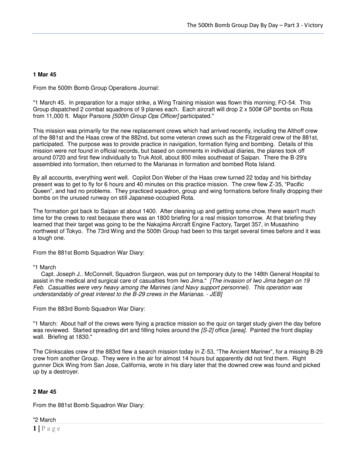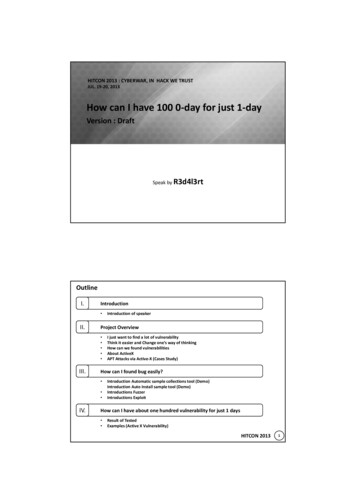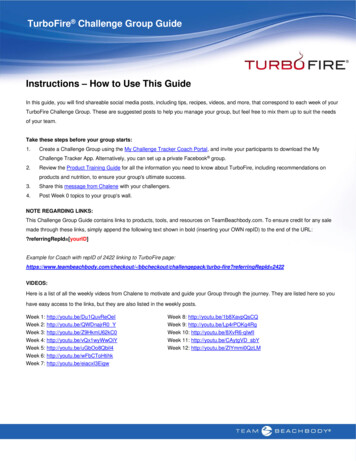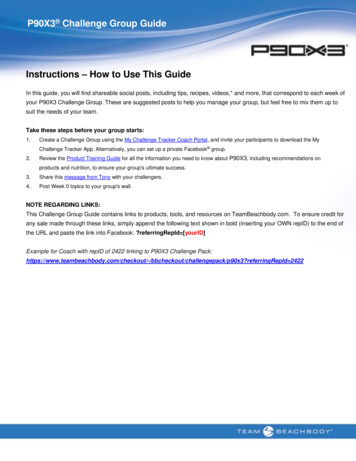
Transcription
The 500th Bomb Group Day By Day – Part 3 - Victory1 Mar 45From the 500th Bomb Group Operations Journal:"1 March 45. In preparation for a major strike, a Wing Training mission was flown this morning; FO-54. ThisGroup dispatched 2 combat squadrons of 9 planes each. Each aircraft will drop 2 x 500# GP bombs on Rotafrom 11,000 ft. Major Parsons [500th Group Ops Officer] participated."This mission was primarily for the new replacement crews which had arrived recently, including the Althoff crewof the 881st and the Haas crew of the 882nd, but some veteran crews such as the Fitzgerald crew of the 881st,participated. The purpose was to provide practice in navigation, formation flying and bombing. Details of thismission were not found in official records, but based on comments in individual diaries, the planes took offaround 0720 and first flew individually to Truk Atoll, about 800 miles southeast of Saipan. There the B-29'sassembled into formation, then returned to the Marianas in formation and bombed Rota Island.By all accounts, everything went well. Copilot Don Weber of the Haas crew turned 22 today and his birthdaypresent was to get to fly for 6 hours and 40 minutes on this practice mission. The crew flew Z-35, “PacificQueen”, and had no problems. They practiced squadron, group and wing formations before finally dropping theirbombs on the unused runway on still Japanese-occupied Rota.The formation got back to Saipan at about 1400. After cleaning up and getting some chow, there wasn't muchtime for the crews to rest because there was an 1800 briefing for a real mission tomorrow. At that briefing theylearned that their target was going to be the Nakajima Aircraft Engine Factory, Target 357, in Musashinonorthwest of Tokyo. The 73rd Wing and the 500th Group had been to this target several times before and it wasa tough one.From the 881st Bomb Squadron War Diary:"1 MarchCapt. Joseph J. McConnell, Squadron Surgeon, was put on temporary duty to the 148th General Hospital toassist in the medical and surgical care of casualties from Iwo Jima." [The invasion of Iwo Jima began on 19Feb. Casualties were very heavy among the Marines (and Navy support personnel). This operation wasunderstandably of great interest to the B-29 crews in the Marianas. - JEB]From the 883rd Bomb Squadron War Diary:"1 March: About half of the crews were flying a practice mission so the quiz on target study given the day beforewas reviewed. Started spreading dirt and filling holes around the [S-2] office [area]. Painted the front displaywall. Briefing at 1830."The Clinkscales crew of the 883rd flew a search mission today in Z-53, “The Ancient Mariner”, for a missing B-29crew from another Group. They were in the air for almost 14 hours but apparently did not find them. Rightgunner Dick Wing from San Jose, California, wrote in his diary later that the downed crew was found and pickedup by a destroyer.2 Mar 45From the 881st Bomb Squadron War Diary:"2 March1 Page
The 500th Bomb Group Day By Day – Part 3 - Victory1st Lt. James M. Pearson's crew left for rest camp on Oahu. Sgt. Richard M. Landsman left for 90 dayrecreational D.S. [detached service] in the United States." [The Pearson crew was the one that brought a badlyshot up Z-11 back from Tokyo on the night of 19 Feb and crash landed into a 497th plane off the runway. - JEB]From the 883rd Bomb Squadron War Diary:"2 March: Mission cancelled. No ground school today. Completed oiling of the floors and changed thedisplays. Combat officers beat the Staff officers 5 to 4 in twelve innings."The mission to Musashino had been postponed due to bad weather. Copilot Don Weber of the Haas crewrecorded in his diary that it rained hard during the night. The postponement gave the crews a double benefit.First, they got to sleep late instead of getting up at 0430. Second, they got to eat the excellent breakfastnormally prepared on mission days – fresh eggs with real butter. To Weber, they “tasted mighty good.”With some time to catch up on things, the Haas and Gillert crews of the 882nd Squadron went up to basefinance to collect their per diem, apparently their travel pay from Herington, Kansas, to Saipan. Weber got 34.25 for the per diem and 101 for his regular pay, plus 150 which was sent home. Weber noted that as a2/Lt on foreign service and with flight pay he now earned 268.50 a month. The extra money was welcome.This afternoon the Haas (882nd), Althoff (881st) and Fitzgerald (881st) crews learned that they and other crewswould be participating in another training mission to Rota tomorrow. Apparently the bad weather betweenSaipan and Japan was expected to continue for another day.Don Weber had still received no mail from home and it was beginning to bother him.3 Mar 45From the 500th Bomb Group Operations Journal:"3 March Group training mission consisting of 21 A/C paid a visit to Rota this morning. A couple of bombs weredropped and the ships were back in the hardstands by 1200."Both the Althoff crew of the 881st Squadron and the Haas crew of the 882nd participated in this training mission,as well as the veteran Fitzgerald crew of the 881st. Copilot Don Weber of the Haas crew got up about 0600,donned his flight suit and went to breakfast. Briefing for the mission was at 0700, take-off about 0830. Bombload was a small number of incendiaries to be deposited on the already heavily pockmarked runway on RotaIsland between Saipan and Guam. But first the group practiced assembly and formation flying by meeting atAnatahan Island north of Saipan and then flying together to a point west of Rota, then turning east and hitting theisland. The whole exercise lasted only a little over two hours.Weber was happy because after AC Otto Haas took the plane up to 12,000 feet and leveled off, he let Weber flyher the rest of the way, in #4 position of #3 element of the lead squadron. It was always good to fly the plane.From the 883rd Bomb Squadron War Diary:"3 March: Office partition painted. Officer Call at 1315 hours. General O'Donnel [sic] addressed the officers andendeavored to explain the rotation plan, censorship, promotion policy. Practice mission flown. Briefing at 2330hours for Mission 28."2/Lt Don Weber of the 882nd was among the officers in O'Donnell's audience. It was his first opportunity to seethe commanding general.S/Sgt Jack Heffner of the 881st Squadron had become an orphan of sorts. He had originally been radaroperator on the McNamer crew, and that was fine, until McNamer was reassigned to Wing and the crew broken2 Page
The 500th Bomb Group Day By Day – Part 3 - Victoryup on 9 Feb. That meant Heffner had to find a new home. He thought he'd found one with the Ray Taylor crewflying as left gunner, which he was willing to do in order to get his quota of missions in, but the command wouldnot reclassify him because trained radar operators were too valuable. So Heffner tried a new home as radaroperator on the Pearson crew and flew a couple of missions with them, including the nearly fatal one of 19 Feb.But it looked like that was not going to become a permanent arrangement either. Yesterday the Pearson crewleft for Hawaii for a well deserved rest leave. but Heffner was not on the orders. That's strange because it wasas a direct result of the 19 Feb incident that the crew had been given the rest leave. But Heffner had somehowbeen overlooked. Well, as I'm sure Jack Heffner would agree, life isn't fair. Anyway, here he was again all byhimself. Then today Heffner was put on DS (Detached Service) to Wing as a radar instructor. That's the way itgoes in the Army. The 500th had obviously been tasked to supply a body with the requisite qualifications andHeffner was available.At 1630 today the crews got the news that the mission to Musashino that had been postponed twice already wason for tonight. Actually, it would be a daylight mission for tomorrow but take-off would be tonight, so as to put thebombers over the target early in the day. Consequently, the mission briefing would be at the unusual time of2330, which meant the crews would have to get up at about 2230. This would the first combat mission as a crewfor the Althoff crew of the 881st, the Haas crew of the 882nd, and other new replacement crews. They had timeto catch a little sleep if they could, but first the gunners had to go up to the line and check their guns.4 Mar 45On this date the 73rd Bomb Wing flew another high-altitude, precision strike against Target 357, the NakajimaAircraft Engine Plant in Musashino near Tokyo. However, there would be a tactical change this time in the hopeof fooling the enemy. The B-29's would take off at night, so as to arrive over the target much earlier than before.Because of the night take-off, there would be no attempt to form up by squadrons or groups. Each plane was tofly individually to the Wing Assembly Point about 100 miles off the coast of Japan. By that time it would bedaylight and the planes would assemble there into formations and proceed to Japan. If an aircraft was unable tofind its own squadron or group formation, it was to join any formation. Planes unable to locate any friendlyplanes were to proceed to Japan individually and bomb the last resort target, the coastal city of Hamamatsu.The 500th Bomb Group contributed 24 planes to this mission, plus two planes to act as Super Dumbos (commsand rescue aircraft) for the entire Wing. The 24 attack planes were nominally divided into two combatsquadrons. Leading the Group and the second squadron was to be Col John B. Montgomery, XXI BomberCommand Chief of Staff, flying with Maj Robert Fitzgerald and crew in Z-8, "Mission to Albuquerque". Leadingthe first squadron would be Lt Col William McDowell, flying with Capt Vance Black and crew in Z-48.The participating planes and crews were:First squadronZ-48, Black/McDowellZ-47, "Adam's Eve", AdamsZ-54, GreggZ-53, "The Ancient Mariner", HolmesZ-50, "Fancy Detail", BradenZ-45, "Mustn't Touch", CheneyZ-52, "20th Century Sweetheart", IrbyZ-51, "Tail Wind", SchmidtZ-32, "Fever from the South", ParsonsZ-26, LimppZ-33, "Slick Dick", HanftZ-22, "Georgia Ann", SasserSecond squadronZ-8, "Mission to Albuquerque", Fitzgerald3 Page
The 500th Bomb Group Day By Day – Part 3 - VictoryZ-9, "Nina Ross", ConnZ-3, "Ann Dee", H. JacksonZ-21, "Devils' Delight", PierceZ-12, MatherZ-4, "Black Magic", AlthoffZ-2, "20th Century Limited", LewisZ-11, CalhounZ-29, "Gravel Gertie", ArbonZ-30, "Sting Shift", GrayZ-34, "Frisco Nannie", FarrellZ-35, "Pacific Queen", HaasThe 500th took off third in the Wing order, between 0141 and 0153. That is, except for three planes from the firstsquadron which were delayed due to problems. Two of these were minor and quickly fixed, and those planestook off immediately after the second squadron, at 0154. Z-53, however, had a more serious problem. Whilemaking her take-off run, one of the life rafts popped out of its compartment in the fuselage above the wing. Thecrew had to abort the take-off and taxi back to have another life raft installed. This took some time, but Z-53finally got off, at 0234.Bomb load for this mission was 13 x 500 lb General Purpose bombs for most planes. Two planes carried 14 ofthese bombs and four planes carried only 10.The planning for this mission included many small but important details. The 500th staff incorporated many ofthese into a page of "Pilot Hints" for use of the crews.//Begin page//500th Bomb GpSAIPANFO #61Mission 284 March 45PILOT HINTS1. Taxi to runway indicated by Aldis lamp located at West end of runway "B".2. Take-off with formation lights on. Flight leaders only will turn on recognitionlights before take-off. Landing lights for take-off is [sic] optional, althoughrecommended. Take off at one minute intervals.3. Assemble in flights while on course to Wing assembly, if possible. (CAS totarget 195)4. Don't test fire until light.5. Turn off all lights at day-break.6. Start climb at approximately 30 degrees 45 minutes N.7. Assemble at 27,000 feet. Group leader will have nose wheel down and will bethe only plane transmitting - - - - - Z Z Z on 585 K.C. while at Wing assembly point.Leader will be circling to left 1/4 needle turn. Altimeter setting for assembly will be29.92 .4 Page
The 500th Bomb Group Day By Day – Part 3 - Victory8. First Group will circle Wing assembly point for 45 minutesSecond Group will circle Wing assembly point for 30 minutesThird Group will circle Wing assembly point for 20 min.Fourth Group will circle Wing assembly point for 15 minutes9. If assembly is not effected at Wing assembly point proceed to control point (landfall) and attempt an assembly there. If less than three ships are together do not go toprimary target.10. Never leave any other aircraft once joined regardless of squadron or group.11. Fly it tight and well forward. Bomb on leader only. If flying with the 498 rememberthey are carrying 2000 pound bombs.12. Homing:497th498th499th500th524534565585AXVZ13. Watch VHF use. Silence except in emergency on way to Target.//End page//Before reaching the Wing Assembly Point one plane, Z-2, turned back due to a swallowed valve in #4 engine.The remaining 23 planes reached the assembly point and attempted to form up as planned.First squadron leader Lt Col McDowell in Z-48 managed to collect five other planes from his squadron, Z-47, Z54, Z-50, Z-51 and Z-45. They were joined by Z-34 from the second squadron and two planes from otherGroups, A-2 from the 497th and T-31 from the 498th, to make a nine-plane formation.Second squadron leader Col Montgomery in Z-8 gathered four other planes from his squadron, Z-9, Z-11, Z-12and Z-30, plus K-34 from the 505th Group of the 313th Wing out of Tinian, for a total of six planes. 2/Lt RobertCopeland, copilot on the Fitzgerald crew in Z-8, was impressed by their passenger, Col Montgomery, for whomthis was the first mission. Copeland thought he was a “a swell guy. one of the nicest I've ever met.”Nine more 500th planes linked up with other formations. Z-29 joined a five-plane formation led by V-8 of the499th Group and also containing V-50, K-20 (505th Group), E-19 (504th Group) and T-2 (498th Group). Z-3 andZ-52 were part of a nine-plane mostly 498th formation led by T-26. Z-22 tagged along with a 14-plane formationled by L-2 (6th Group). Z-26 was with a 12-plane squadron led by A-46 of the 497th. Z-33, Z-35 and Z-4 joineda mostly 497th squadron of 11 planes led by A-10. And Z-53, the plane that took off late due to the popped liferaft, ended up leading a four-plane element in an 11-plane squadron led by A-6.The mixed formations headed off for the IP, the city of Kofu, where they turned onto the planned course of 86degrees. Meanwhile, the last two 500th planes, Z-21 and Z-32, having been unable to find any friendly planes,bombed Hamamatsu individually as directed.As the formations approached the primary target, a familiar scenario replayed itself. The primary was completelycovered with clouds. Accurate bombing of the relatively small factory grounds would be impossible, so allplanes diverted to the secondary target, the urban area of Tokyo. The city was also cloud-covered, but as alarge area target, it could be bombed effectively by radar. Target 357 had been saved by weather again.As the various formations passed over Tokyo, they dropped their loads between 0941 and 1005 from altitudes5 Page
The 500th Bomb Group Day By Day – Part 3 - Victoryranging from 26,000 to 28,000 feet. Due to the thick undercast, no bombing results could be observed or anystrike photos taken.All 500th planes bombed successfully except for three. Z-34 was able to drop only half of her bombs. It waslater found that the shackle on the lower forward rack had been loaded backwards. Two planes failed to dropany bombs at all, Z-53 due to a bomb door malfunction and Z-35 due to a short in the bomb circuit. Z-53 wasable to salvo her bombs later, but Z-35 could not and the rookie Haas crew had to lug all ten bombs all the wayback to Saipan.Due either to the bad weather or the surprise of the early bombing, there was no fighter opposition. The onlydamage suffered by the 500th on this mission was two planes slightly damaged by flak. Z-9 was holed in theelevator, the left wing tip and the back of the rear bomb bay. Z-11 was hit in the right wing, including a hole inthe fuel tank access panel outboard of #4 engine.All planes returned safely to base, landing between 1435 and 1740. The extra weight of the 10 bombs theycouldn't get out of the bomb bay slowed down the Haas crew in Z-35 and made them one of the last planes toland, after a long 15 hours in the air. But copilot Don Weber wasn't complaining. This was his first mission andhe expressed thanks to God for making it an easy one and permitting him to come home safely. Also taking along time to make it home, 15 hours and 40 minutes according to right gunner Joseph Altott, was the new Althoffcrew of the 881st in Z-4. Altott added, “We sweated out our fuel on the return trip and landed with barely enoughat 1630 hours.”5 Mar 45The Haas crew of the 882nd Squadron had been exhausted after their long mission of yesterday, but copilot DonWeber was dedicated enough to get up early this morning at 0715 to eat breakfast and get his laundry ready tosend out.There was a Squadron critique of yesterday's mission at 1030 and a Group critique later at 1330, both attendedby most if not all crews. After that the still tired Weber was hoping to take a nap but learned at 1500 that hiscrew had been assigned to test fly a plane, which they took up for 50 minutes. As was customary on Saipan,some sailors came along for the ride.Later, an exhausted Weber wrote in his diary that he had now flown on four out of five days for a total of 26hours. He also noted with disappointment that he had still received no mail.Some of the veteran crews were getting very unhappy with the lack of progress on several issues impacting theirlives. 2/Lt Harold Towner, bombardier on the Hays crew, confided to his diary today, “Our rest leave is stillpending. Hays [AC 1/Lt Hale Hays] has had no word of his promotion, no decorations have been approved, westill do not know how many missions will get us that trip home, and I for one am getting extremely disgusted withthe whole set up.”There was a practice air raid alert on Saipan tonight, which to young Robert Copeland of the Fitzgerald crew“sounded like old times again except that there was no Ack ack.” There had been no Japanese air attacks forover two months.From the 500th Bomb Group Operations Journal:"5 March.WSM 256. Lt Hays, in Z Square 23 ["Ramblin Roscoe"], took off 0600 K employing flight plan "A". Returned tobase at 2000 K.WSM 257. Lt Setterich employing flight plan "C" took off at 1200 K in Z Square 43. Returned 0200 K.WSM 258. Lt Booze employing flight plan "G" took off 2100 K in Z Square #6 ["Booze Hound"]. Returned at1100 K."6 Page
The 500th Bomb Group Day By Day – Part 3 - VictoryThe weather strike mission routes had been standardized and designated by letters. A was a route to Okinawaand the Ryukyu Islands. C was to the Tokyo area. G was to the Hiroshima area on southern Honshu.73rd Bomb Wing WSM reports and personal diaries provide us with more details on these missions:WSM-256 was simply a weather mission with no bombs or cameras carried. 2/t Harold Towner, bombardier onthe Hays crew of the 882nd Squadron, wrote in his diary that most of Okinawa was covered by clouds. Therewas no opposition. Towner added, “The weather interrogation, according to message picked up by Koert [radiooperator Sgt Henry Koert – JEB], was to be held at Guam, so we set our course to that island instead of Saipan.It was the first visit to Guam for most of us, but it could have been any Army airfield.” Towner's entry implies thatthe crew was not told prior to take-off to fly to Guam, which seems strange.WSM-257 did include a bombing assignment, 17 x M18 incendiaries to be dropped on the Tokyo urban area,which was accomplis
donned his flight suit and went to breakfast. Briefing for the mission was at 0700, take-off about 0830. Bomb load was a small number of incendiaries to be deposited on the already heavily pockmarked runway on Rota Island between Saipan and Guam. But first the gr











